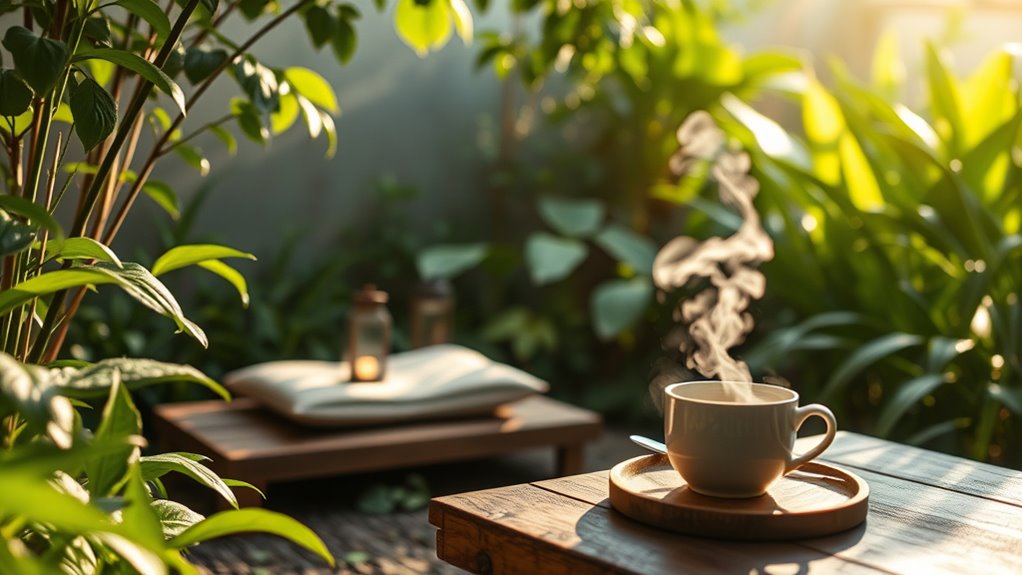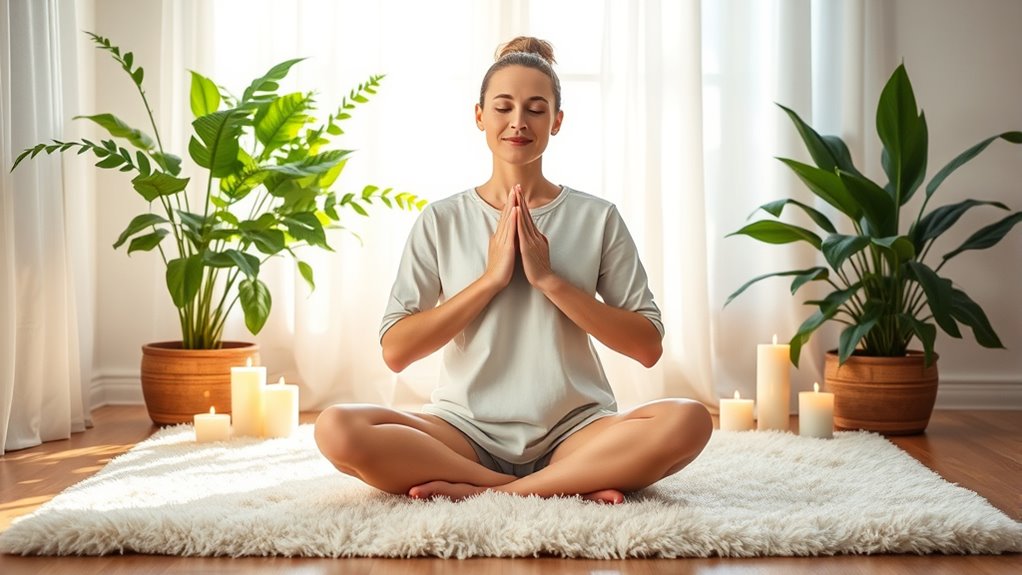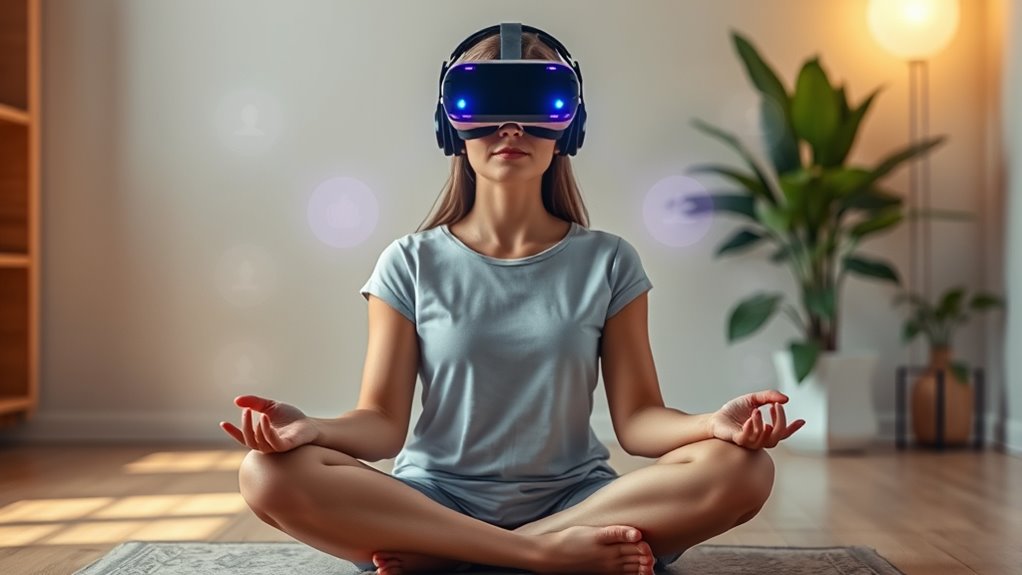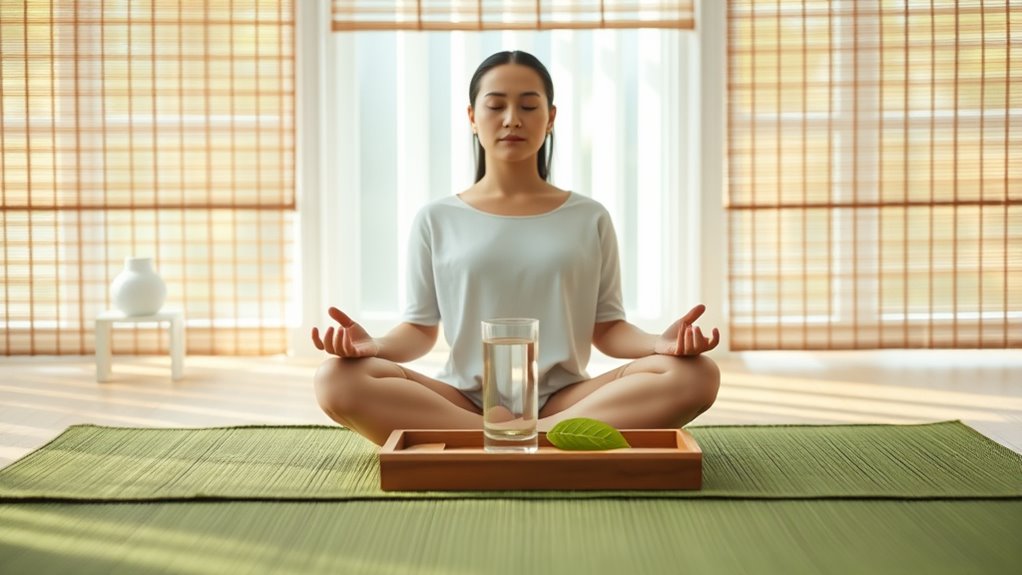Mindfulness & Well‑Being
Meditation Micro‑Retreats: Short Daily Escapes for Busy People
Busy schedules can benefit from quick meditation micro-retreats that restore focus and calm—discover how these brief escapes can transform your day.

If you’re busy and need a quick way to center yourself, micro-retreats are ideal. These short, intentional moments—like mindful breathing or guided visualizations—help you recharge and reduce stress anytime during your day. You don’t need special equipment; just a few minutes to focus on your breath or imagine calming scenes can make a big difference. Keep going to discover simple ways to incorporate these powerful mental escapes into your routine.
Key Takeaways
- Micro-retreats are brief, intentional breaks designed to fit into busy schedules, promoting self-connection and mental well-being.
- Practices like mindful breathing and guided visualizations can be completed in just a few minutes to reduce stress.
- Customizable and flexible, micro-retreats can be tailored to individual preferences and available time slots.
- Regular short escapes enhance focus, clarity, and calmness, supporting mental health amid hectic routines.
- Even brief moments of mindfulness during the day help reset the mind and foster a sense of centeredness and peace.

In today’s busy world, finding time for a full meditation retreat can feel impossible, but that’s where micro-retreats come in. These short, intentional breaks let you reconnect with yourself without disrupting your hectic schedule. Even just a few minutes can make a noticeable difference, helping you reset and regain focus amid your daily chaos. The key is to create a space—whether physically or mentally—that allows you to step back from constant activity and tune into your inner state. Micro-retreats are flexible, so you can fit them into your day whenever you need a mental recharge. Incorporating evidence-based insights can enhance the effectiveness of your micro-retreats, ensuring they support your mental well-being. One simple and effective way to deepen your micro-retreat is through mindful breathing. This practice involves paying close attention to your breath, observing each inhale and exhale with curiosity and without judgment. When you focus on your breath, you anchor yourself in the present moment, pushing away worries about the past or future. You might find it helpful to set a timer for five minutes and just breathe naturally, feeling the rise and fall of your chest or the coolness of the air passing through your nose. Mindful breathing doesn’t require any special equipment or quiet space—just your awareness. It’s a powerful tool for calming your nervous system and cultivating a sense of peace, even during a hectic day.
Micro-retreats offer quick, flexible ways to reconnect and reset amidst a busy schedule.
Guided visualization is another effective technique you can incorporate into your micro-retreat. This involves listening to a recorded or live guide who takes you on a mental journey, often imagining serene landscapes or positive scenarios. Visualization helps you detach from stressful thoughts and immerse yourself in calming imagery, activating your parasympathetic nervous system. You can do this during a short pause at work or in your commute, closing your eyes and following the guide’s instructions. As you visualize a peaceful beach or a lush forest, your body responds as if you’re experiencing those places firsthand, reducing tension and promoting relaxation. Combining guided visualization with mindful breathing can amplify your sense of tranquility, making even a few minutes feel like a restorative escape.
The beauty of micro-retreats is their adaptability. You can customize them to suit your schedule and preferences—whether it’s a quick breath meditation during a lunch break or a longer visualization session before bed. The goal is consistency; the more regularly you carve out these moments, the more natural they become. Over time, you’ll notice increased clarity, reduced stress, and a greater sense of presence throughout your day. Micro-retreats aren’t about perfection—they’re about honoring your need for mental space and nourishment in a busy world. With just a few moments dedicated to mindful breathing or guided visualization, you give yourself a precious gift: a small but powerful pause that keeps you grounded and centered.
Frequently Asked Questions
Can Micro-Retreats Replace Longer Meditation Retreats?
Micro-retreats can’t fully replace longer retreats, but they offer a valuable form of deep immersion in your daily routine. Short daily escapes help you maintain mindfulness and reduce stress, making consistent practice easier. While longer retreats provide more profound experiences and intensive learning, micro-retreats fit busy schedules and keep you connected to your meditation journey. They complement each other, enhancing your overall mindfulness and well-being.
What Are the Best Times of Day for Micro-Retreats?
Like a gentle breeze, the best times for micro-retreats are during mindful mornings and evening reflections. You’ll find starting your day with a brief retreat sets a calm tone, while evening sessions help you unwind and process. These moments fit seamlessly into your routine, giving you a quick mental reset. By choosing these peaceful times, you guarantee your micro-retreats become a consistent, rejuvenating part of your busy schedule.
How Do I Stay Consistent With Daily Micro-Retreats?
To stay consistent with daily micro-retreats, focus on habit formation by setting a specific time each day, like morning or lunch break. Use mindfulness practices as a anchor, making it easier to integrate into your routine. Keep reminders visible, track your progress, and celebrate small wins. Over time, these simple steps will reinforce your commitment, making daily micro-retreats a natural part of your busy schedule.
Are There Specific Locations Ideal for Short Escapes?
You’ll find urban parks and quiet cafes ideal for short escapes because they offer peaceful environments close to your daily routine. Parks provide natural tranquility and fresh air, perfect for grounding yourself, while cafes give a cozy, quiet space for reflection. Choose locations that are easily accessible, free from distractions, and allow you to disconnect quickly. These spots make it simple to incorporate micro-retreats into your busy day.
Can Beginners Easily Incorporate Micro-Retreats Into Their Routines?
Getting your foot in the door is easier than you think. You can easily incorporate micro-retreats into your routine by starting with beginner-friendly techniques like mindful breathing or short body scans. These quick mindfulness practices fit seamlessly into busy schedules, making meditation accessible for everyone. With consistency, you’ll find it becomes a natural part of your day, helping you stay centered no matter how hectic things get.
Conclusion
Embracing meditation micro-retreats can seamlessly fit into your busy schedule, offering quick escapes that refresh your mind and renew your spirit. Just like carving out a secret passage in your day, these tiny breaks can transform your outlook and bring calm amidst chaos. So, don’t wait for the perfect moment—grab your modern-day scroll and start today. Remember, even in this fast-paced world, a few mindful minutes can be your sanctuary, your own little Renaissance.
Mindfulness & Well‑Being
Mindful Self‑Compassion: Treating Yourself Kindly
Caring for yourself with mindful compassion can transform your emotional resilience—discover how gentle kindness in tough moments can unlock inner strength.

Practicing mindful self-compassion means intentionally being kind to yourself, especially during tough times. When you notice feelings of disappointment or overwhelm, pause and acknowledge your emotions without judgment. Use gentle affirmations like “It’s okay to feel this way.” Developing this compassionate approach helps build emotional resilience and fosters a sense of connection to your feelings. By consistently treating yourself kindly, you’ll find it becomes easier to handle setbacks and cultivate inner strength, opening the door to greater well-being.
Key Takeaways
- Practice pausing to observe and acknowledge your emotions with kindness instead of self-criticism.
- Use affirmations like “It’s okay to feel this way” to foster a compassionate inner dialogue.
- Develop empathy for yourself, recognizing struggles as part of the human experience.
- Reframe setbacks as opportunities for growth, building emotional resilience through self-compassion.
- Consistently nurture self-kindness to enhance well-being and manage difficult moments more effectively.

Have you ever wondered how you treat yourself during difficult times? It’s easy to be your harshest critic when life gets tough, but practicing mindful self-compassion can dramatically change that. When you approach yourself with kindness instead of judgment, you develop empathy development that strengthens your connection to your own feelings. This isn’t about self-indulgence or ignoring problems; it’s about recognizing your pain without adding shame or blame. As you become more aware of your inner experience, you start to see that struggles are a universal part of being human. This awareness fosters emotional resilience, helping you bounce back more quickly from setbacks. Instead of spiraling into negativity, you learn to hold your feelings with gentle acceptance, which builds a stable foundation for facing future challenges.
In the moment when you’re feeling overwhelmed or disappointed, pause and notice what’s going on inside. Instead of criticizing yourself for feeling upset, acknowledge your emotions with compassion. Say to yourself, “It’s okay to feel this way,” or “Everyone goes through tough times.” This simple act of kindness shifts your mindset from one of resistance to one of understanding. As you do this regularly, you start to develop a more empathetic inner voice that doesn’t judge but comforts. Over time, this practice enhances your empathy development, allowing you to extend that same compassion outward toward others. You realize that everyone, including you, deserves kindness during times of hardship. Engaging in these practices can also activate the Law of Attraction, aligning your mindset with positive outcomes and creating a ripple effect of well-being.
Building emotional resilience through mindful self-compassion isn’t about avoiding pain but about learning to sit with it without being overwhelmed. When you treat yourself kindly, you’re less likely to get caught in negative thought patterns that drain your energy. Instead, you create space for growth and healing. You begin to see setbacks not as personal failures but as opportunities to learn and grow stronger. This shift in perspective is essential for resilience, as it encourages you to face difficulties with patience and understanding rather than frustration. Over time, this resilience becomes a core part of how you handle stress, making difficult moments less intimidating and more manageable. By consistently practicing mindfulness and self-compassion, you reinforce your capacity to care for yourself, nurture inner strength, and sustain your emotional wellbeing through life’s inevitable ups and downs.
Frequently Asked Questions
How Can I Practice Self-Compassion During Stressful Moments?
During stressful moments, you can practice self-compassion by taking deep, mindful breaths to calm your mind. Acknowledge your feelings without judgment and speak to yourself kindly. Try compassionate journaling to express your emotions and offer gentle support. This helps you stay present and gentle with yourself, reducing stress. Remember, treating yourself with patience and understanding in tough times fosters resilience and emotional well-being.
What Are Common Barriers to Developing Self-Compassion?
You might face barriers like cultural expectations that emphasize toughness or self-criticism, making it hard to be kind to yourself. Fear of vulnerability also holds you back, as opening up about your feelings can feel unsafe or uncomfortable. These obstacles can prevent you from practicing self-compassion, but recognizing them is the first step. Gradually challenge these beliefs, and remind yourself that kindness toward yourself is essential for growth and resilience.
Can Self-Compassion Improve Mental Health Outcomes?
Imagine planting a seed that blossoms into emotional resilience; self-compassion acts as that nurturing water. It can profoundly improve your mental health by fostering positive psychology, reducing stress, and boosting self-esteem. When you treat yourself kindly, you build a more resilient mind capable of weathering life’s storms. Embracing self-compassion transforms your inner dialogue, creating a foundation for lasting well-being and emotional strength.
How Does Self-Compassion Differ From Self-Indulgence?
Self-compassion differs from self-indulgence because it involves balancing self-love with healthy boundaries and self-care. While self-criticism destroys confidence, self-compassion encourages you to treat yourself kindly during setbacks. Self-indulgence, on the other hand, often ignores boundaries and may temporarily soothe but doesn’t foster genuine growth. Practicing self-compassion means nurturing yourself without overdoing it, promoting mental well-being while maintaining accountability and respect for your limits.
Are There Specific Exercises to Enhance Self-Kindness?
Think of self-kindness exercises as watering your inner garden. You can enhance self-compassion through guided meditations that focus on loving kindness, which help you send compassion to yourself. Practice daily by repeating gentle affirmations or engaging in loving kindness exercises, where you intentionally send warmth and understanding to your heart. These simple acts nurture your well-being, making kindness a natural part of your daily life.
Conclusion
Think of self-compassion as tending to a delicate garden. When you water it with kindness and prune away harsh judgments, it blossoms with resilience and peace. Remember, you’re both the gardener and the bloom—nurturing yourself with gentle care. As sunlight warms each leaf, let understanding and patience shine within. By tending your inner garden kindly, you create a space where growth, healing, and self-love flourish naturally and beautifully.
Mindfulness & Well‑Being
Technology & Mindfulness: VR Meditation and Future Tools
Discover how cutting-edge technology like VR meditation and AI is transforming mindfulness practices and what exciting innovations lie ahead to enhance your journey.

Technology is revolutionizing mindfulness with immersive tools like VR meditation, which transports you to calming environments, reducing distractions and enhancing focus. AI personalizes your experience, analyzing mood and stress levels to suggest tailored exercises, while wearables provide real-time physiological feedback, prompting breathing or relaxation techniques. Future innovations will combine these tools seamlessly, offering personalized virtual spaces and real-world prompts. Keep exploring how these advancements could transform your mindfulness journey into more engaging and effective practices.
Key Takeaways
- VR meditation creates immersive environments that reduce distractions and enhance focus during mindfulness practice.
- AI personalizes VR experiences by adapting environments and guidance based on user responses and physiological data.
- Wearable devices monitor bodily responses, enabling real-time feedback and tailored mindfulness prompts within VR sessions.
- Future tools include AR overlays and AI virtual coaches to make mindfulness more accessible and engaging in daily life.
- Integration of soundscapes, narratives, and immersive tech transforms mindfulness into interactive, personalized experiences for diverse users.

Have you ever wondered how technology influences your ability to stay present? In today’s fast-paced world, it’s easy to get overwhelmed by constant notifications, multitasking, and digital distractions. But technology also offers tools that can enhance your mindfulness practice, making it more accessible and personalized. AI integration, for instance, plays a pivotal role in tailoring experiences to your needs. Smart algorithms analyze your responses, mood, and progress, helping you customize meditation sessions that resonate with you. These intelligent systems can suggest exercises based on your stress levels or emotional state, guiding you to deeper relaxation and focus.
Technology personalizes mindfulness by analyzing responses and moods to suggest tailored meditation experiences.
Wearable devices further revolutionize how you engage with mindfulness. Devices like smartwatches or fitness bands monitor your physiological signals—heart rate, skin conductance, or even sleep patterns—and provide real-time feedback. This data helps you become more aware of your body’s responses during meditation or everyday moments. For example, if your wearable detects heightened heart rate due to stress, it might prompt you to take a few deep breaths or shift to a calming meditation session. These devices bridge the gap between technology and your physical experience, making mindfulness more tangible and immediate.
Additionally, VR meditation takes this synergy to another level. Virtual reality immerses you in calming environments—beach scenes, lush forests, or serene temples—that help you disconnect from external chaos. The immersive aspect minimizes distractions, enabling you to focus solely on your breathing or visualizations. As you interact with these virtual worlds, technology guides you through mindfulness exercises, often incorporating AI to adapt the experience based on your reactions. This dynamic interaction keeps you engaged and ensures that the practice remains effective over time.
Looking ahead, future tools will likely integrate even more seamlessly into your daily life. Imagine wearable devices that not only monitor your physiological signals but also suggest personalized VR environments to help you reset during stressful moments. Augmented reality could overlay calming visuals or prompts in your real-world surroundings, making mindfulness a natural part of your routine. AI-powered virtual coaches might offer real-time guidance, encouraging you to stay present or adjust your focus as needed. Moreover, as the speaking style used by professionals like those on the National Geographic Channel demonstrates, incorporating engaging narratives and immersive soundscapes can further enhance the effectiveness of these tools. These innovations will make mindfulness practices more intuitive, accessible, and tailored to your unique needs.
In essence, technology is transforming mindfulness from a solitary, often abstract practice into an interactive, personalized experience. By blending AI integration, wearable devices, and VR meditation, you gain powerful tools that support your journey to staying present amidst life’s chaos. Embracing these advancements lets you harness the full potential of technology to foster a calmer, more centered mind every day.
Frequently Asked Questions
How Accessible Are VR Meditation Tools for Different Age Groups?
You’ll find VR meditation tools are becoming increasingly accessible across different age groups, thanks to improved design and user-friendly interfaces. Younger people tend to adopt new tech quickly, but older adults are gradually embracing these tools through simplified setups and guided instructions. As tech adoption widens, age accessibility improves, making VR meditation a viable option for everyone seeking mindfulness benefits. This trend highlights how technology continues to bridge generational gaps in wellness practices.
What Are the Potential Risks of Using VR for Mindfulness Practices?
Using VR for mindfulness can pose risks like cybersickness, causing nausea or dizziness during sessions. You might also experience emotional desensitization if overusing the technology, which could dull your emotional responses over time. To minimize these risks, take regular breaks, limit session duration, and stay mindful of how VR affects your well-being. Always listen to your body and consult professionals if you notice adverse effects.
How Do VR Meditation Experiences Compare to Traditional Methods?
VR meditation offers a heightened sensory immersion that can deepen your mindfulness experience compared to traditional methods. The realism enhancement makes virtual environments feel more authentic, helping you focus and relax more effectively. However, it may lack the tactile and personal connection of face-to-face practices. While VR can be a powerful tool, it’s essential to balance it with conventional meditation for well-rounded mindfulness and avoid over-reliance on technology.
Can VR Mindfulness Tools Be Integrated Into Daily Routines Effectively?
Yes, VR mindfulness tools can be effectively integrated into your daily routines. By making it easy to access, you can develop a mindfulness habit that fits seamlessly into your day. Set aside a few minutes each morning or evening to use VR meditation, helping you stay consistent and focused. With regular practice, these tools can enhance your overall well-being and make mindfulness a natural part of your daily life.
What Future Technological Advancements Could Enhance VR Meditation Experiences?
Future advancements could revolutionize your VR meditation experience, with AI customization expected to tailor sessions to your mood and goals. Sensory integration will likely deepen immersion, engaging your senses more fully for relaxation. Studies show 75% of users report increased calmness with personalized content. These innovations will make your practice more effective and immersive, helping you achieve mindfulness more effortlessly and consistently in your daily routine.
Conclusion
As you step into a virtual world of serenity, technology becomes your mindful companion, blending innovation with calm. Imagine the bustling city outside, loud and chaotic, while inside your headset, a peaceful forest awaits. This contrast reminds you that future tools can bridge the gap between stress and stillness. Embracing VR meditation lets you navigate both worlds effortlessly, turning digital landscapes into personal sanctuaries where mindfulness and technology unite to transform your well-being.
Mindfulness & Well‑Being
Fasting & Mindfulness: Combining Nutrition and Awareness
Harnessing fasting and mindfulness together unlocks deeper health insights and emotional resilience—discover how this powerful combination can transform your well-being.

Combining fasting with mindfulness helps you develop a deeper, more respectful relationship with food and your body. By paying close attention to hunger cues, textures, and flavors, you can improve digestion, boost mental clarity, and increase emotional resilience. This approach encourages awareness of your physical signals and emotional needs, making your fasting journey more meaningful and sustainable. Keep exploring how blending nutrition and mindfulness can release bigger health benefits for you.
Key Takeaways
- Combining fasting with mindfulness enhances mental clarity, emotional stability, and overall well-being through increased awareness of bodily signals.
- Mindful fasting encourages savoring food, slowing down, and differentiating genuine hunger from emotional cravings.
- Integrating personal data and predictive analytics optimizes fasting routines for improved physical and mental health.
- Mindfulness during fasting fosters self-awareness, compassion, and a respectful relationship with food and body.
- A holistic approach links nutrition and awareness to support sustainable, effective fasting practices and overall wellness.

Fasting and mindfulness are powerful tools that, when combined, can enhance your mental clarity, emotional stability, and overall well-being. By practicing mindful fasting techniques, you not only improve your physical health but also deepen your awareness of your body’s signals and your relationship with food. One of the key advantages of this approach is the variety of intermittent benefits you can experience. These benefits extend beyond weight management, affecting your energy levels, digestion, and mental focus. When you pay close attention to your fasting periods, you become more in tune with your body’s needs, which helps prevent overeating and emotional eating.
Combining fasting and mindfulness boosts mental clarity, emotional stability, and overall well-being beyond just weight management.
Mindful fasting techniques involve more than just abstaining from food; they require you to be present during your eating and fasting windows. During your eating periods, you focus on savoring each bite, noticing textures, flavors, and scents. This heightened awareness slows down your eating, promoting better digestion and reducing the likelihood of overeating. During fasting periods, mindfulness encourages you to observe hunger cues without acting impulsively. You learn to differentiate between genuine hunger and habitual or emotional cravings. This awareness creates a more balanced relationship with food, allowing you to make intentional choices rather than reacting out of habit or emotion.
Incorporating mindful fasting techniques also helps you recognize the subtle signals your body sends. For example, you might notice that your energy dips at certain times or that your mood fluctuates in response to your fasting schedule. These insights give you greater control over your well-being and help you tailor your fasting routine to suit your individual needs. Additionally, mindful fasting encourages compassion towards yourself, reducing guilt or frustration if you slip up. This gentle, non-judgmental approach fosters consistency and sustainability in your fasting practice.
Furthermore, aligning your fasting practices with insights from predictive analytics can help you optimize your routine based on your personal data and patterns. As you develop a routine that combines mindful fasting techniques with intermittent benefits, you’ll notice changes in your mental clarity. Clearer thinking, improved concentration, and emotional resilience become more accessible. This holistic approach supports your overall health by integrating awareness with nutrition, making the experience more meaningful and effective. Ultimately, mindful fasting is about cultivating a respectful, attentive relationship with your body and food. When you approach fasting with mindfulness, you *release* its full potential—supporting your physical health while nurturing your mental and emotional well-being.
Frequently Asked Questions
Can Fasting Improve Mental Clarity and Focus?
Yes, fasting can improve your mental clarity and focus. Intermittent benefits from fasting, like increased alertness, often lead to enhanced mental sharpness. When you fast, your body releases more brain-boosting chemicals, helping you stay attentive and clear-headed. Over time, many find that fasting supports sustained concentration, making it a valuable tool for boosting mental performance and maintaining sharpness throughout your day.
What Are the Best Mindfulness Techniques During Fasting?
Think of your mind as a peaceful pond—calm and clear. During fasting, practice mindfulness meditation to steady your thoughts and deepen your body awareness. Focus on your breath, sensations, and the present moment, like tuning into a gentle melody. These techniques help you stay grounded, reduce cravings, and foster inner calm, making fasting a more mindful journey. Keep your attention soft and compassionate toward yourself.
How Does Fasting Affect Emotional Well-Being?
Fasting can boost your emotional well-being by strengthening emotional resilience and lowering stress levels. As you fast, you may find it easier to manage emotional triggers and stay calm under pressure. The practice encourages self-awareness and discipline, which promotes stress reduction. Over time, fasting can help you develop a more balanced outlook, increasing your capacity to handle life’s emotional challenges with greater resilience and a clearer, calmer mind.
Are There Specific Foods That Enhance Mindfulness?
You notice a piece of dark chocolate melting slowly in your mouth, and suddenly, you’re practicing mindful eating. Foods like berries, nuts, and leafy greens naturally enhance food mindfulness by engaging your senses. These mindful eating choices encourage presence and gratitude, helping you stay attuned to hunger cues and savor each bite. Incorporating such foods into your diet fosters greater awareness, making every meal a moment of nourishment and mental clarity.
How Do I Start Combining Fasting With Mindfulness Practices?
To start combining fasting with mindfulness practices, begin by practicing meditation techniques that focus on breath and body awareness during your fasting periods. Incorporate mindful eating when you break your fast, paying attention to textures, flavors, and your hunger cues. Gradually extend your fasting windows while maintaining this mindful approach. This helps you develop a deeper connection with your body, making fasting a more conscious and enriching experience.
Conclusion
By blending fasting with mindfulness, you can deepen your awareness of hunger and nourishment, making each meal more meaningful. Imagine Sarah, who started practicing mindful fasting and discovered she felt more in tune with her body’s signals, leading to healthier choices and increased energy. When you pay close attention to your body’s cues during fasting, you not only improve your physical health but also foster a stronger connection to your overall well-being.
-

 Wish Notes1 year ago
Wish Notes1 year agoBest Caption to Wish Myself a Happy Birthday That Everyone Will Like!
-

 Wish Notes1 year ago
Wish Notes1 year agoThe Best Birthday Wishes to Make Your Uncle's Day Bright!
-

 Wish Notes1 year ago
Wish Notes1 year agoThe Sweetest Happy Birthday Wishes for Your Wife!
-

 Wish Notes1 year ago
Wish Notes1 year agoThe Best Happy Birthday Wish for Your Brother That Will Make Him Smile!
-

 Wish Notes1 year ago
Wish Notes1 year agoHeartwarming Birthday Messages for Mom in Spanish
-

 Wish Notes1 year ago
Wish Notes1 year agoThe Best Happy Birthday Wishes for Your Husband That Will Make His Day!
-

 Wish Notes1 year ago
Wish Notes1 year agoThe Ultimate Birthday Wishes to Celebrate Yourself!
-

 Wish Notes1 year ago
Wish Notes1 year agoThe Most Heartfelt Good Night Wishes Ever!






















